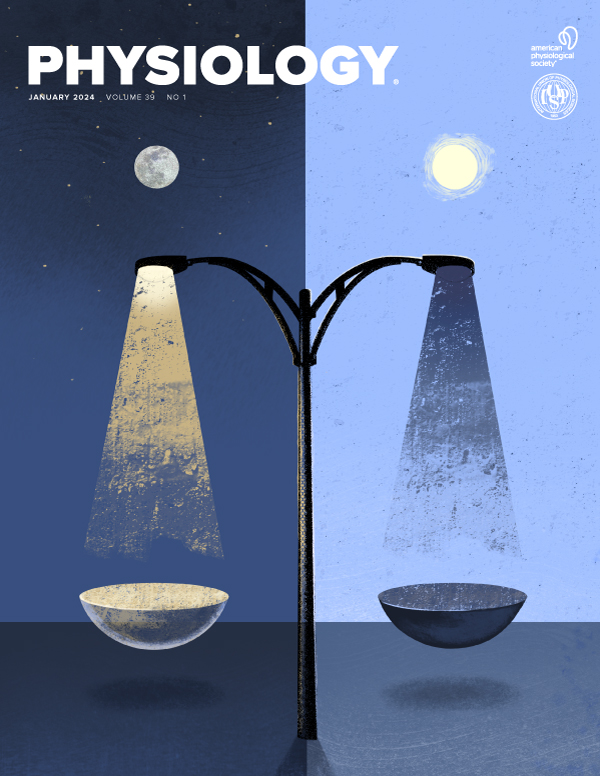Placental programming mediates the vicious cycle between maternal gestational diabetes and offspring type 2 diabetes in a novel mouse model
IF 5.3
2区 医学
Q1 PHYSIOLOGY
引用次数: 0
Abstract
Accumulating evidence from human epidemiological studies indicates that there is a vicious cycle between maternal gestational diabetes (GDM) and offspring type 2 diabetes (T2D). However, the underlying mechanisms remain unclear. A handful of studies found that mitochondrial defects occur in the GDM placenta, including excess accumulation of destroyed mitochondria, reduced ATP and enhanced ROS production, which indicates that mitophagy, a specific process to remove destroyed mitochondria, may be impaired in the GDM placenta. Our recent study suggested that BNIP3 plays a critical role in maintaining mitochondria homeostasis in human trophoblast cells. Therefore, in this study, we hypothesized that conditional knockout of BNIP3 specifically in mouse trophoblast cells will recapitulate the typical symptoms of GDM in maternal pregnancy and T2D in offspring. First, we made male mice with double homozygous Cre and LoxP by breeding Cyp19-Cre and Bnip3-LoxP mice, which was used to mate females with homozygous LoxP, forming a cKO group. On the other hand, wild-type female mice were bred by males with homozygous Cre, forming a control group (CT). Second, offspring from cKO and CT mothers were allowed to grow up. On Day 18 of pregnancy, glucose tolerance test was conducted in pregnant cKO or CT mice. The placental tissues were collected and mRNA and protein levels of BNIP3 were measured by qPCR and Western blotting, respectively. In male offspring at the age of eight months, glucose tolerance test was conducted, and metabolic rate was measured by CaloBox Indirect Calorimetry. All numerical parameters between the cKO and CT pregnant mice, and between their male offspring were analyzed by ANOVA (n=5). The main findings include: 1) On Day 18 of pregnancy, BNIP3 mRNA and protein levels in the placental tissue were reduced by 47% and by 40% in cKO compared to CT mice (p<0.05), respectively (p<0.05); 2) Pregnant cKO mice demonstrated enhanced glucose intolerance compared to those control mice; 3) At the age of 8 months, the body weight of male offspring from cKO mothers was increased by 1.16-fold (p<0.05) compared to those from CT mothers; 4) Male offspring from cKO mothers demonstrated enhanced glucose intolerance compared to those from CT mothers; 5) The metabolic rates was lower in male offspring from cKO mothers compared to those from CT mothers, with decreased oxygen consumption and carbon dioxide production by 1.18- and 1.19-fold, respectively (p<0.05). These results suggest that placental programming possibly via the disrupted functions of BNIP3 in trophoblast cells mediates the occurrence of maternal GDM and offspring T2D, therefore, placental BNIP3 may play a critical role in the vicious cycle of maternal GDM and offspring T2D and thus, being a potential target in treatment of GDM and prevention of T2D. NIH research grants R03HD095417, U54MD007597. This is the full abstract presented at the American Physiology Summit 2024 meeting and is only available in HTML format. There are no additional versions or additional content available for this abstract. Physiology was not involved in the peer review process.在一种新型小鼠模型中,胎盘编程介导母体妊娠糖尿病与子代 2 型糖尿病之间的恶性循环
人类流行病学研究积累的证据表明,母体妊娠糖尿病(GDM)与子代 2 型糖尿病(T2D)之间存在恶性循环。然而,其根本机制仍不清楚。少数研究发现,GDM 胎盘中存在线粒体缺陷,包括被破坏的线粒体过量堆积、ATP 减少和 ROS 生成增加,这表明在 GDM 胎盘中,清除被破坏线粒体的特定过程--有丝分裂吞噬(mitophagy)可能受损。我们最近的研究表明,BNIP3 在维持人滋养层细胞线粒体平衡中起着关键作用。因此,在本研究中,我们假设在小鼠滋养层细胞中特异性有条件敲除 BNIP3 将重现母体妊娠 GDM 和子代 T2D 的典型症状。首先,我们通过繁殖Cyp19-Cre和Bnip3-LoxP小鼠,制作出Cre和LoxP双同源的雄性小鼠,并用其与同源LoxP的雌性小鼠交配,形成cKO组。另一方面,野生型雌性小鼠与带有同源Cre的雄性小鼠交配,形成对照组(CT)。其次,让 cKO 和 CT 母鼠的后代长大。妊娠第 18 天,对妊娠 cKO 或 CT 小鼠进行葡萄糖耐量试验。收集胎盘组织,分别用 qPCR 和 Western 印迹法测定 BNIP3 的 mRNA 和蛋白水平。对 8 个月大的雄性后代进行葡萄糖耐量试验,并用 CaloBox 间接量热计测量代谢率。cKO 和 CT 怀孕小鼠之间及其雄性后代之间的所有数值参数均采用方差分析(n=5)。主要研究结果包括1)妊娠第 18 天,与 CT 小鼠相比,cKO 小鼠胎盘组织中的 BNIP3 mRNA 和蛋白水平分别降低了 47% 和 40%(p<0.05)(p<0.05);2)与对照小鼠相比,妊娠 cKO 小鼠表现出更强的葡萄糖不耐受性;3)8 个月大时,cKO 母亲的雄性后代体重增加了 1.16倍(p<0.05);4)与CT母鼠相比,cKO母鼠的雄性后代表现出更强的葡萄糖不耐受性;5)与CT母鼠相比,cKO母鼠的雄性后代代谢率更低,耗氧量和二氧化碳产生量分别减少了1.18倍和1.19倍(p<0.05)。这些结果表明,胎盘编程可能通过滋养层细胞中 BNIP3 的功能紊乱介导了母体 GDM 和子代 T2D 的发生,因此,胎盘 BNIP3 可能在母体 GDM 和子代 T2D 的恶性循环中起着关键作用,从而成为治疗 GDM 和预防 T2D 的潜在靶点。美国国立卫生研究院研究基金 R03HD095417、U54MD007597。这是在 2024 年美国生理学峰会上发表的摘要全文,只有 HTML 格式。本摘要没有附加版本或附加内容。生理学》未参与同行评审过程。
本文章由计算机程序翻译,如有差异,请以英文原文为准。
求助全文
约1分钟内获得全文
求助全文
来源期刊

Physiology
医学-生理学
CiteScore
14.50
自引率
0.00%
发文量
37
期刊介绍:
Physiology journal features meticulously crafted review articles penned by esteemed leaders in their respective fields. These articles undergo rigorous peer review and showcase the forefront of cutting-edge advances across various domains of physiology. Our Editorial Board, comprised of distinguished leaders in the broad spectrum of physiology, convenes annually to deliberate and recommend pioneering topics for review articles, as well as select the most suitable scientists to author these articles. Join us in exploring the forefront of physiological research and innovation.
文献相关原料
| 公司名称 | 产品信息 | 采购帮参考价格 |
|---|
 求助内容:
求助内容: 应助结果提醒方式:
应助结果提醒方式:


